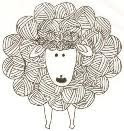This question is posed in the light of a copyright statement on a scarf which is done in the sea foam stitch. Google 'seafoam stitch' and numerous sites show how this delightful stitch creates the illusion of foam as it 'mimics the undulating movement sea foam makes as it lies on top of the water'. This stitch makes use of the double yarn over and is worked over a multiple of 10 plus 6 stitches and the instructions can be found for free on several sites. But if you want to make a scarf using this stitch to sell you are supposed to purchase the pattern which grants you the right to sell items made from the pattern! Surely copyright protects your intellectual property, but these patterns have been around for centuries, and were exchanged between knitters freely, as can be seen in the surviving hand-knitted lace samplers.
Currently I am currently knitting/designing a poncho
This one starts at the cowl neck and is worked from the top down - so no seams, just cast on, knit and then cast off and its ready to wear! This sample is knit in some bulky yarn that I dyed for another project, I could dye some more, but I'm not sure that I want a poncho in this colour!
Which brings me on to dyeing and this week's experiments. This last week has been wet and windy and much of the countryside is flooded, including the area between me and Dorset, so my planned trip to this county has been delayed until the waters go down! So in the meantime and to keep me from going slightly bonkers I have been experimenting with dye absorption - or to be more precise how much dye can a fibre absorb?
To make my poncho I have decided that I need a dark colour - can't decide between dark winter green or red - or going down the safe route of dark gray or even black. But which ever colour I chose it has to be a very solid colour. These pencil rovings, approx 250grams in weight, have each been dyed with 15grams of dye powder and are uniform in colour, but best was there was no exhaust and the resulting colour is uniform!
Now all these tests are fine, but I procrastinate - I really need to be a brave girl and make a decision and dye the yarn so that I can knit the poncho before winter gives way to spring!




















